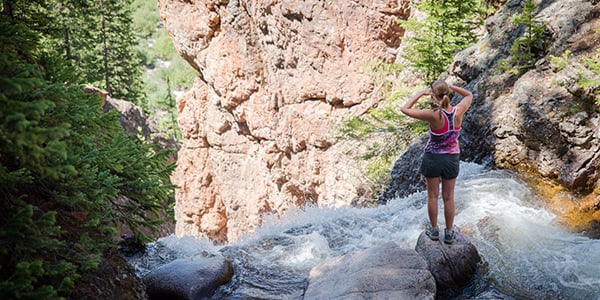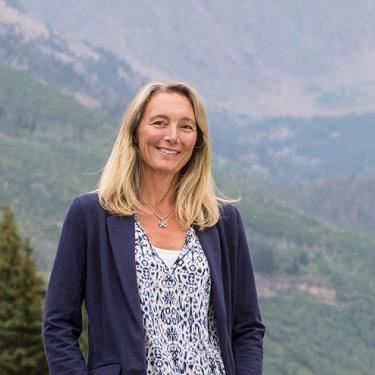
A woman stands near the edge of Booth Falls in Vail. Local trails are visited by hundreds of thousands of people each year. This high use has contributed to issues such as trash, pet waste, trail erosion and widening, social route development, parking challenges at trailheads and a decline in local deer and elk populations.
What will our mountain communities look like in 50 years? How do we imagine and create a sustainable future? Mountains are more vulnerable to the effects of climate change than many other regions (Kohler, et. Al., 2009) and the COVID-19 pandemic highlights the need to diversify our tourism dependent mountain resort economies while creating equity and economic resilience for all. Amidst the complexity and crises we find ourselves in, we must create spaces in our lives for long-term thinking and ingenuity. The past successes of our mountain resort communities demonstrate we are pioneering and innovative, they demonstrate we can do this.
A 2019 Intergovernmental Panel on Climate Change report sheds light on the global forces impacting high mountain areas we must grapple with as we make our way forward. Winter mountain snow cover is shrinking up to 10 days per decade. Changes in the seasonality of snow runoff is impacting our rivers and cold water fish. Species of plants and animals are changing as new warmer habitats open up and colder refugia are reduced. Tourism and recreation have already been negatively affected by declining snow cover and its impacts on summer recreation. These trends will intensify and continue throughout the century. Integrated cross-sector management and effective governance is needed to reduce vulnerability to these impacts. Fortunately the Eagle County community has established action oriented framework to pave a path forward.
The Climate Action Collaborative and the Eagle County Community Resilience Plan call for local strategies to reduce our greenhouse gas (GHG) emissions while creating more sustainable and resilient economic development. Our sustainable mountain tourism sector depends on a healthy vibrant community of year-round residents with meaningful well-paying jobs. According to the Colorado Department of Local Affairs tourism currently accounts for 60% of Eagle County’s economy. Economists warn no sector should account for more than 30% of the economy. Herein lies a nexus of crisis and opportunity to invigorate new economies and fill the economic gap. The COVID-19 pandemic provides the space for us to rethink and imagine the future of our mountain home.
Let’s use some of this collaborative trust and momentum to use our valley’s collective imagination to focus on a long-term sustainable vision. There are opportunities emerging for innovation and entrepreneurism to reduce GHG emissions and generate mountain economic development that protects and enhances the natural open spaces that sustain us.
The first opportunity is sustainable food and agriculture. Momentum is underway with the Knapp Ranch and Hoophouse. More valley-wide resources that provide year-round employment are needed alongside continued protection and cultivation of the valley’s agricultural lands and soils. Jackson Hole’s Vertical Harvest greenhouse is an example we can follow.
The second opportunity is transportation and mobility. The 2017 Eagle County GHG Inventory Report illustrates that vehicles are the greatest source of local GHG emissions. Our communities must be re-envisioned to include priority infrastructure for pedestrians, bicycles, electric vehicles, and public transportation. A variety of creative sustainable mobility industries and their associated jobs can be generated to serve, assist and enrich people while moving up and down the Eagle Valley.
The third opportunity is housing. Sustainable, affordable, net zero community housing built in previously developed areas close to town centers, transportation hubs, and jobs. New housing must be built hand-in-hand with emerging sustainable food, transportation, jobs, and access to open spaces, and must be built for year-round residents.
Fourth, protection and restoration of open spaces, forests, rivers, and wildlife habitat. This ongoing opportunity, which can be overlooked from the perspective of traditional economic development provides physical, emotional, and spiritual benefits of being outdoors in the mountains and are key to the behavioral health of our community. Climate warming increases the risk and frequency of wildland fires and forest insect outbreaks. Innovative partnerships with U.S. Forest Service, Bureau of Land Management, Colorado Parks and Wildlife, local governments, and private landowners can improve the health of mountain habitats while supporting human and ecological health.
Finally, imagination and creativity must be cultivated through education, arts and training. Call this the creative learning economy. Educational opportunities that help us see one another, and our world, in new ways; and that cultivate interdisciplinary long-term thinking, and prepare people to lead and in these emergent sustainable economies are critical. Enticing career pathways must be accessible to all and tailored to meet the needs of our diverse community.
There are people who need immediate support to sustain themselves and their families, as there are severe inequities and injustices in our society and we must tackle these immediate threats while aiming to address underlying issues. At the same time, for those who are facing new windows of time and space, the time has never been better to seize opportunities, think long-term, and strengthen the creative capacities for a sustainable mountain community.








